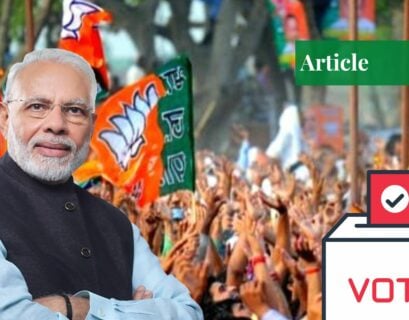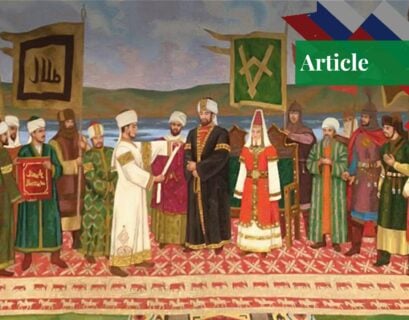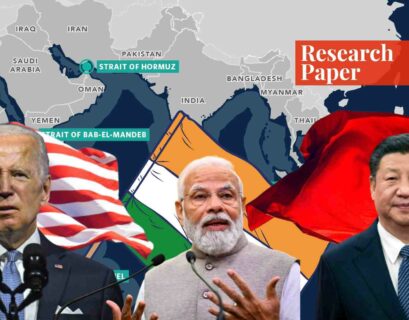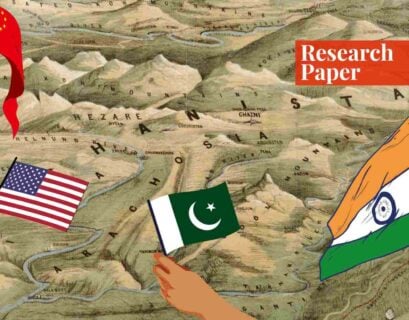Introduction
Hindutva is the brainchild of a Hindu supremacist writer and politician, Vinayak Damodar Savarkar, who wrote a pamphlet titled “Hindutva: Who is a Hindu?” in 1923. It fueled a kind of religious nationalism that would later transform itself into ultranationalism. This political ideology was taken up by the Rashtriya Swayamsevak Sangh (RSS) and its political wing.
Hindutva stands on religious nationalism as opposed to the civic nationalism of secular India. Hindutva works on the basis of ‘othering’, an idea introduced and deconstructed by Edward Said in his revolutionary postcolonial work, Orientalism. According to Said, the European colonial masters worked on creating a divide between the uncivilized and civilized world, the orient and the occident, while creating an ‘us vs. them’ sentiment.
Modi’s government has given teeth to this ideology and brought it to the forefront of Indian politics. Right-wingers uphold Hindutva as a religion and a way of life; a carefully drafted project for the political mobilization of Hindus (Noorani, 2016). It is a political agenda of aggrandizing the majority religious group by exploiting their fragile sentiments.
The current government works by othering Muslims and it has illegitimately radicalized the Indian society against the ‘Muslim threat’. It is creating a Hindu vs. Muslim divide, trying to expel Muslims from the Indian state to make it purely Hindu. This practice of glorifying Hinduism by these ultranationalist forces is popularly termed Saffronization which intends to color the Indian society saffron (Syed, 2019). The color represented the Maratha empire, and it is now worn by RSS and Hindutva followers.
BJP was backed by Hindu nationalist forces to instill and exploit anti-Muslim sentiments even before it was officially in power. This was the force behind the demolition of the Babri Masjid by a saffron-clad mob which prompted a series of riots and killed hundreds of people (Basu, 2018). The Gujarat riots of 2002 were orchestrated during Modi’s term as the Chief Minister of Gujarat.
Modi also passed the Citizenship Amendment Act (CAA) which allows the followers of some religions an easier and fast-track naturalization process, of which Muslims are not a part (The Economist, 2020). He has attacked the pluralism of Indian society, and the secular grounds on which it has stood since independence.
His regime disturbs the societal setup of India by over-empowering a specific segment of the society and treating minorities as a threat. This creates the ground for communal violence through economic and social disparity along religious lines. Moreover, Modi’s regime is diseased with fascist tendencies which make the world’s largest democracy a breeding ground for religious feuds (Griswold, 2019).
The ultra-nationalism, xenophobia against Muslims, Modi’s anti-secularism, the erosion of various civil liberties, and using force against the opposition, are not the practices of a democratic state (Ahmad Z., 2020).
Deconstructing Hindutva
Hindutva means “Hinduness”, which, according to Savarkar, should have been the national identity in independent India. It sets the criteria for being called a Hindu i.e., anyone who considers India his motherland, fatherland, and holy land, is called a Hindu. At a glance, it seems that Hindutva is an inclusive concept because it allows various religious minorities to be assimilated. However, a deeper understanding of the concept shows that it works by dividing Indian society.
Hindutva creates a national identity that includes certain religions but particularly excludes Abrahamic religions (Islam and Christianity). In this way, it creates a sentiment of ‘us vs. them’ (Hindus vs. Muslims) and fuels a social divide. This is the manifestation of the colonial mentality of othering that Edward Said unmasked in Orientalism. Hindutva itself is the mirror image of the colonial mindset of racial and religious supremacy over the orient, the Muslims in this case.
Savarkar lived in the era when Nazism was evolving in Germany, and he often praised it to be a savior of Germany. He drew parallels between India and Germany, between Indian Muslims and German Jews. Although he did not openly call for the extermination of Indian Muslims, he equated them with German Jews in a very subtle way, hinting towards their expulsion, if not extermination (Pirbhai, 2020).
Indian newspapers appraised the transformation in Italy as a viable alternative to democracy which has manifested itself in today’s India through CAA (Leidig, 2020). Modi’s right-wing government has these similarities with Nazi Germany and fascist Italy of the mid-20th century. Practices such as xenophobia against Muslim and Hindu ultra-nationalism make it easy for scholars to relate the Modi government with fascism.
Simply put, Hindutva forces want a Hindu Rashtra, not a secular India. They criticize Congress’ secularism to be a tool for appeasing minorities, while they want to exclude those minorities altogether. The CAA of 2019, the revocation of Kashmir’s constitutional autonomy, and the ban on hijab in schools in Kerala are the manifestation of this motive of Hindu supremacy (Serhan, 2020).
Exclusion of Muslims
The Citizenship Amendment bill was passed in the upper house of the Indian parliament, Rajya Sabha, on 11th December 2019 (BBC, 2019). The bill amended Indian citizenship rules which previously allowed illegal migrants to acquire citizenship in India. It says that only a person living in India for more than 11 years and who has worked for the federal government can apply for citizenship.
The bill secures those who flee from religious persecution from the neighboring countries and allows those who entered India illegally before 31st December 2014 to apply for citizenship (Deka, 2019). Muslim immigrants from neighboring states of India are excluded from this category, and those living in India for years are labeled infiltrators.
Hindutva followers consider Hinduism as the only way of life. This is why they only include Buddhism, Jainism, Zoroastrianism, and Sikhism because these four religions share a common culture with Hindus in India. This was a rather diplomatic move to easily exclude Muslims from the national fabric of India (Sharma, 2020).
Destructive Tendencies of Hindu Nationalism
Indian nationalists do not favor this kind of Hindu nationalism that translates itself into extremism and hatred against Muslims. Shashi Tharoor openly criticized Hindutva for distorting the teachings of a peaceful religion of Hinduism. According to Shashi Tharoor, Hinduism had been able to assert itself without threatening other religions and people.
The followers of Hindutva have contributed to communal violence aimed at Muslims mostly (The Economic Times, 2019). In his attempts to promote Hindu nationalism, Modi took a hardline stance on the Kashmir conflict, which in turn helped him in getting electoral success. The Hindu extremist government decided to use brutal force against any movement in Kashmir, rather than engaging the people in dialogue.
The Indian government also blamed Pakistan for the Pulwama attack and used it as a basis for its nationalist rhetoric, a month before the Indian elections. The abrogation of Articles 370 and 35A of the Indian Constitution has taken away Kashmir’s political autonomy and special status, an act praised by Hindu nationalists because they can change the demographics of the region now by assimilating the Hindu population into the Muslim-majority Kashmir.
India’s Radicalization Through Hindutva
There is a visible change in Indian society and politics with the BJP coming to power. India has been radicalized over the past few years, a trend that has been supported and promoted by the Hindutva government. Radicalization is the process by which individuals in a society develop radical and extreme views about a group of people; political, religious, or even social. Radicalization often leads to violent extremism in a state (Randy, 2011).

In the case of India, radicalism is being promoted by the government through various policies at the grassroots level. Little acts such as banning certain history textbooks, and replacing them with books that promote a pro-Hindu narrative of Indian history, will go a long way in brainwashing religiously charged Hindus. These attempts to saffronize Indian history have radicalized Indian society considerably.
Romila Thapar’s “Medieval India” was criticized on account of being too sympathetic towards Muslims, and not enough sympathetic towards Hindu revivalism (Rudolph & Rudolph, 1983). Just like the colonizer’s orientalism worked by creating a discourse to satisfy their motives, the Modi government is forging its version of truth for the generations to come. India did not swiftly turn radical; instead, it was a methodical process, promoted by the top Hindu nationalist forces including the government.
Narratives of the ‘Muslim Threat’
With little progress to show in terms of the economy, the only remaining platform for BJP and Modi was nationalism. BJP created a sense of fear among Hindus regarding Muslims and portrayed them as foreigners and invaders. It has created discourses that legalize those policies and actions, including their support of vigilantism. The media has become the mouthpiece for promoting ultra-nationalism and xenophobia (Islam, 2020).
Modi also uses the security discourse to gather support from the masses. The government legitimizes the violence in the name of countering the extremism of Muslims within India and across Pakistan. Even those who do not believe in Hindu supremacy, support the government in various other ways through these discourses (Islam, 2020).
Illiberal Turn of Indian Democracy
The core idea of a democracy is to limit the control of the government. India is experiencing the opposite of that, as the executive aggrandizement of the BJP is leading towards a decaying democracy of India. The government equates political opposition with treason, making it easier to target and arrest political opponents, especially targeting the Congress Party (Khaitan, 2020).
The anti-minority laws highlight the cracks in India’s liberal democracy. BJP-led government in the state of Maharashtra passed a law that penalized the possession and consumption of beef. This is an infringement on individual privacy and the right to life and liberty under Article 21 of the Indian constitution. The only way Modi has been successful in violating the constitution is because he has done it subtly and incrementally, without any direct assault on the constitution.
A stable democracy requires executive accountability, ensuring that those in power do not concentrate it in their own hands and foreclose this possibility for their political opponents. Executive accountability is increasingly becoming a myth in the world’s largest democracy. Modi is a democratic leader, or at least elected through a democratic process, who gathered support from the Hindu nationalist base during his first term.
To secure another term in the office, he sought to exploit the anti-Muslim sentiments in the public in the name of Hindu nationalism. He exploited the fragile religious sentiments which are easier to radicalize given the right motives. It was the Hindu supremacy and extremism that was disguised as nationalism, which led to the radicalization of Indian society.
A Hindu Rashtra in Process
The right-wing regime is trying to bring about demographic changes in various regions of the country, as the core idea is to increase the Hindu-to-Muslim ratio and to shuffle the Muslim majority. The starkest example of this is the revocation of Kashmir’s autonomous status through Articles 370 and 35A.
Article 370, of which article 35A was a part, allowed the state of Jammu and Kashmir to govern itself. The state had its constitution, a separate flag, and its laws, while the central government in India controlled the defense and foreign affairs of the state. The article also protected the demographics of the region by not allowing outsiders permanent residency and ownership of property in the territory of the state.
It was in the election manifesto of the BJP in 2019 to revoke this article in the name of integrating Kashmir into the Indian state. Home minister Amit Shah said that “Article 370 was a hindrance in the process of democratization in the region, as it did not allow development while corruption became rampant”. Shortly after that, Kashmir was put under lockdown.
In desperate attempts to increase the Hindu gene pool, the ideological mentor of the BJP, the RSS, continues to advise Hindu couples to produce more children so it would increase the Hindu population. Since Indian society is patriarchal, BJP promotes Hindu men marrying Muslim women while discouraging the marriages of Hindu women with Muslim men (Khaitan, 2020).
Conclusion
Hindutva works on the same colonial ideas of creating an ‘us vs. them’ as Orientalism talks about, dividing society into warring segments. It acknowledges Hindus for being superior to others in every sense of the word and thereby asks for the expulsion and marginalization of Muslims. Modi government has practically included this ideology in their policies and acts.
The cracks in Indian democracy have now started to show themselves to the world, as India is slowly drifting away from its constitutional norms under a right-wing extremist government. Modi furthered this ideology by bypassing the CAA which seeks to eliminate Muslims. For the first time in history, Indian citizenship is being granted on a religious basis. This politicization of Hinduism at the hands of Modi is radicalizing India to the extent that analysts fear the future of democracy has become uncertain.
Under the government of the right-wing BJP, the curriculum in schools is updated to align with the broader aim of saffronization. The attempts to saffronize Indian history have radicalized society through racism and Hindu supremacy (Halarnkar, 2020). Modi is not only playing on the politics of ultra-nationalism but also taking India towards authoritarianism and xenophobia while opposing the liberal democratic framework that has held India together up till now.
References
- Acevedo, D. D. (2018). Secularism in the Indian Context. Laws and social inquiry .
- Akbar, M. (2018). A brief history of democracy. Retrieved from Indian Express: https://indianexpress.com/article/opinion/columns/a-brief-history-of-democracy-independence-day-political-stability-5307035/
- Anderson, J. (2006). Religion, Democracy And Democratization. Routledge.
- Banaji, S. (2018). Vigilante Publics: Orientalism, Modernity and Hindutva Fascism in India. Javnost – The Public .
- Basu, A. (2018). Whither Democracy, Secularism, and Minority Rights in India. The Review of Faith & International Affairs, 16 (4).
- BBC. (2019). Article 370: What happened with Kashmir and why it matters. Retrieved from BBC: https://www.bbc.com/news/world-asia-india-49234708
- BBC. (2019). Citizenship Amendment Bill: India’s new ‘anti-Muslim’ law explained. Retrieved from BBC: https://www.bbc.com/news/world-asia-india-50670393
- BBC. (2015). Indian PM Narendra Modi makes surprise visit to Pakistan. Retrieved from BBC: https://www.bbc.com/news/av/world-asia-35178506
- Deka, K. (2019). Everything you wanted to know about the CAA and NRC. Retrieved from India Today: https://www.indiatoday.in/india-today-insight/story/everything-you-wanted-to-know-about-the-caa-and-nrc-1630771-2019-12-23
- Economic Times. (2016). Indian federal system of governance under threat from Modi Government: CPI(M). Retrieved from Economic Times: https://economictimes.indiatimes.com/news/politics-and-nation/indian-federal-system-of-governance-under-threat-from-modi-government-cpim/articleshow/50596021.cms?from=mdr
- Griswold, E. (2019). The Violent Toll of Hindu Nationalism in India. Retrieved from The New Yorker: https://www.newyorker.com/news/on-religion/the-violent-toll-of-hindu-nationalism-in-india
- Gupta, D. (2017). Are we turning into a nation of hyper-nationalists? Retrieved from The Hindu: https://www.thehindu.com/opinion/op-ed/are-we-turning-into-a-nation-of-hyper-nationalists/article18701484.ece
- Halarnkar, S. (2020). The growing radicalisation of Hindus threatens the Indian republic and the Constitution. https://scroll.in/article/949101/the-growing-radicalisation-of-hindus-threatens-indias-republic-and-the-constitution
- Islam, R. (2020). Hindu Nationalism: A Rise of New Religious Radicalism in India. Retrieved from INSAMER:
- Khaitan, T. (2020). Killing a Constitution with a Thousand Cuts: Executive Aggrandizement and Party-state Fusion in India. Law & Ethics of Human Rights.
- Noorani, A. G. (2016). What is Hindutva? Retrieved from Dawn: https://www.dawn.com/news/1301496
- Pirbhai, M. R. (2020). Hindutva and the Meaning of Modernity. Retrieved from Berkeley Forum: https://berkleycenter.georgetown.edu/responses/hindutva-and-the-meaning-of-modernity
- Randy, B. (2011). Radicalization into Violent Extremism I: A Review of Social Science Theories. Journal of Strategic Security.
- Rudolph, L. I., & Rudolph, S. H. (1983). Rethinking Secularism: Genesis and Implications of the Textbook Controversy. Pacific Affairs.
- Serhan, Y. (2020). The End of the Secular Republic. Retrieved from The Atlantic: https://www.theatlantic.com/international/archive/2020/08/modi-erdogan-religious-nationalism/615052/
- Sharma, A. (2020). On the difference between Hinduism and Hindutva. Education About Asia, 25 (1).
- The Economic Times. (2019). Hindutva is an assault on Hinduism: Shashi Tharoor. Retrieved from The Economic Times: https://economictimes.indiatimes.com/news/politics-and-nation/hindutva-is-an-assault-on-hinduism-shashi-tharoor/articleshow/71358702.cms?from=mdr
- The Economist. (2020). Narendra Modi threatens to turn India into a one-party state. Retrieved from The Economist: https://www.economist.com/briefing/2020/11/28/narendra-modi-threatens-to-turn-india-into-a-one-party-state
If you want to submit your articles and/or research papers, please check the Submissions page.
The views and opinions expressed in this article/paper are the author’s own and do not necessarily reflect the editorial position of Paradigm Shift.



















